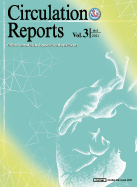3 巻, 6 号
選択された号の論文の12件中1~12を表示しています
- |<
- <
- 1
- >
- >|
Original Articles
Cardiac Rehabilitation
-
原稿種別: ORIGINAL ARTICLE
専門分野: Cardiac Rehabilitation
2021 年 3 巻 6 号 p. 311-315
発行日: 2021/06/10
公開日: 2021/06/10
[早期公開] 公開日: 2021/05/27PDF形式でダウンロード (707K) HTML形式で全画面表示
Cardiovascular Intervention
-
原稿種別: ORIGINAL ARTICLE
専門分野: Cardiovascular Intervention
2021 年 3 巻 6 号 p. 316-323
発行日: 2021/06/10
公開日: 2021/06/10
[早期公開] 公開日: 2021/05/29PDF形式でダウンロード (863K) HTML形式で全画面表示
Heart Failure
-
原稿種別: ORIGINAL ARTICLE
専門分野: Heart Failure
2021 年 3 巻 6 号 p. 324-332
発行日: 2021/06/10
公開日: 2021/06/10
[早期公開] 公開日: 2021/05/18PDF形式でダウンロード (716K) HTML形式で全画面表示
Hypertension and Circulatory Control
-
原稿種別: ORIGINAL ARTICLE
専門分野: Hypertension and Circulatory Control
2021 年 3 巻 6 号 p. 333-337
発行日: 2021/06/10
公開日: 2021/06/10
[早期公開] 公開日: 2021/05/12PDF形式でダウンロード (979K) HTML形式で全画面表示
Myocardial Disease
-
原稿種別: ORIGINAL ARTICLE
専門分野: Myocardial Disease
2021 年 3 巻 6 号 p. 338-344
発行日: 2021/06/10
公開日: 2021/06/10
[早期公開] 公開日: 2021/05/27PDF形式でダウンロード (759K) HTML形式で全画面表示
Valvular Heart Disease
-
原稿種別: ORIGINAL ARTICLE
専門分野: Valvular Heart Disease
2021 年 3 巻 6 号 p. 345-353
発行日: 2021/06/10
公開日: 2021/06/10
[早期公開] 公開日: 2021/05/26PDF形式でダウンロード (1616K) HTML形式で全画面表示
Images in Cardiovascular Medicine
-
原稿種別: IMAGES IN CARDIOVASCULAR MEDICINE
2021 年 3 巻 6 号 p. 354-355
発行日: 2021/06/10
公開日: 2021/06/10
[早期公開] 公開日: 2021/05/20PDF形式でダウンロード (551K) HTML形式で全画面表示 -
原稿種別: IMAGES IN CARDIOVASCULAR MEDICINE
2021 年 3 巻 6 号 p. 356-357
発行日: 2021/06/10
公開日: 2021/06/10
[早期公開] 公開日: 2021/05/25PDF形式でダウンロード (596K) HTML形式で全画面表示
Letters to the Editor
-
原稿種別: LETTER TO THE EDITOR
2021 年 3 巻 6 号 p. 358-
発行日: 2021/06/10
公開日: 2021/06/10
[早期公開] 公開日: 2021/05/29PDF形式でダウンロード (301K) HTML形式で全画面表示 -
原稿種別: AUTHOR’S REPLY
2021 年 3 巻 6 号 p. 359-
発行日: 2021/06/10
公開日: 2021/06/10
[早期公開] 公開日: 2021/05/29PDF形式でダウンロード (310K) HTML形式で全画面表示
Corrigendum
-
原稿種別: CORRIGENDUM
2021 年 3 巻 6 号 p. 360-
発行日: 2021/06/10
公開日: 2021/06/10
PDF形式でダウンロード (345K) HTML形式で全画面表示
-
2021 年 3 巻 6 号 p. Content6-
発行日: 2021/06/10
公開日: 2021/06/10
PDF形式でダウンロード (638K)
- |<
- <
- 1
- >
- >|
